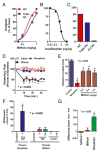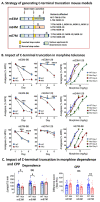Exploring Pharmacological Functions of Alternatively Spliced Variants of the Mu Opioid Receptor Gene, Oprm1, via Gene-Targeted Animal Models
- PMID: 35328429
- PMCID: PMC8950057
- DOI: 10.3390/ijms23063010
Exploring Pharmacological Functions of Alternatively Spliced Variants of the Mu Opioid Receptor Gene, Oprm1, via Gene-Targeted Animal Models
Abstract
The mu opioid receptor has a distinct place in the opioid receptor family, since it mediates the actions of most opioids used clinically (e.g., morphine and fentanyl), as well as drugs of abuse (e.g., heroin). The single-copy mu opioid receptor gene, OPRM1, goes through extensive alternative pre-mRNA splicing to generate numerous splice variants that are conserved from rodents to humans. These OPRM1 splice variants can be classified into three structurally distinct types: (1) full-length 7 transmembrane (TM) carboxyl (C)-terminal variants; (2) truncated 6TM variants; and (3) single TM variants. Distinct pharmacological functions of these splice variants have been demonstrated by both in vitro and in vivo studies, particularly by using several unique gene-targeted mouse models. These studies provide new insights into our understanding of the complex actions of mu opioids with regard to OPRM1 alternative splicing. This review provides an overview of the studies that used these gene-targeted mouse models for exploring the functional importance of Oprm1 splice variants.
Keywords: OPRM1; alternative splicing; animal model; gene targeting; mu opioid receptor; opioid.
Conflict of interest statement
Y.-X.P. is a scientific co-founder of Sparian Biosciences. All other authors declare no conflict of interest.
Figures




Similar articles
-
Alternative Pre-mRNA Splicing of the Mu Opioid Receptor Gene, OPRM1: Insight into Complex Mu Opioid Actions.Biomolecules. 2021 Oct 15;11(10):1525. doi: 10.3390/biom11101525. Biomolecules. 2021. PMID: 34680158 Free PMC article. Review.
-
Mu Opioids Induce Biased Signaling at the Full-Length Seven Transmembrane C-Terminal Splice Variants of the mu Opioid Receptor Gene, Oprm1.Cell Mol Neurobiol. 2021 Jul;41(5):1059-1074. doi: 10.1007/s10571-020-00973-5. Epub 2020 Oct 8. Cell Mol Neurobiol. 2021. PMID: 33033993 Free PMC article.
-
Tetrapeptide Endomorphin Analogs Require Both Full Length and Truncated Splice Variants of the Mu Opioid Receptor Gene Oprm1 for Analgesia.ACS Chem Neurosci. 2016 Dec 21;7(12):1717-1727. doi: 10.1021/acschemneuro.6b00240. Epub 2016 Oct 10. ACS Chem Neurosci. 2016. PMID: 27648914 Free PMC article.
-
Sex Associated Differential Expressions of the Alternatively Spliced Variants mRNA of OPRM1 in Brain Regions of C57BL/6 Mouse.Cell Physiol Biochem. 2018;50(4):1441-1459. doi: 10.1159/000494644. Epub 2018 Oct 25. Cell Physiol Biochem. 2018. PMID: 30359988
-
Endogenous Opioid Peptides and Alternatively Spliced Mu Opioid Receptor Seven Transmembrane Carboxyl-Terminal Variants.Int J Mol Sci. 2021 Apr 6;22(7):3779. doi: 10.3390/ijms22073779. Int J Mol Sci. 2021. PMID: 33917474 Free PMC article. Review.
Cited by
-
A Balancing Act: Learning from the Past to Build a Future-Focused Opioid Strategy.Annu Rev Physiol. 2024 Feb 12;86:1-25. doi: 10.1146/annurev-physiol-042022-015914. Epub 2023 Nov 29. Annu Rev Physiol. 2024. PMID: 38029388 Free PMC article. Review.
-
Interactive effects of morphine and the HIV integrase inhibitor, cabotegravir, in male and female mice.Biomed Pharmacother. 2025 Mar;184:117925. doi: 10.1016/j.biopha.2025.117925. Epub 2025 Feb 24. Biomed Pharmacother. 2025. PMID: 39999644 Free PMC article.
References
-
- Martin W.R. Opioid Antagonists. Pharmacol. Rev. 1967;19:463–521. - PubMed
Publication types
MeSH terms
Substances
Grants and funding
LinkOut - more resources
Full Text Sources
Research Materials

